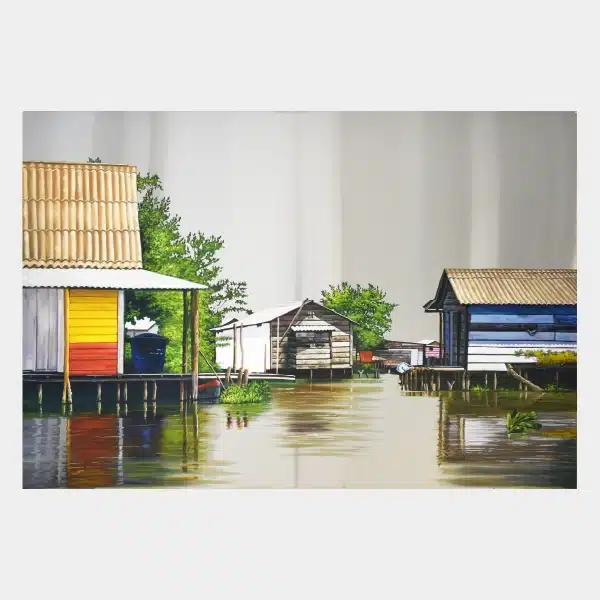
Sequences: the image-montage: Sair García’s new exhibition at MAMBO
The Museo de Arte Moderno de Bogotá (MAMBO) presents the exhibition Secuencias: la imagen montaje, an ambitious project by Colombian artist Sair Garc

Oil on stainless steel
230 x 440 cm Políptico
90.55 x 173.22 Polyptych

Oil on stainless steel
50 x 50 cm
19.68 x 19.68 in

Oil on canvas
50 x 50 cm
19.68 x 19.68 in

Oil on stainless steel
60 x 63 cm
23.62 x 24.80 in

Oil on stainless steel
110 x 160 cm
43.30 x 63 in

Bronze
35 x 33 x 35 cm
13.77 x 13 x 13.77 in

Oil on stainless steel
50 x 50 cm
19.68 x 19.68 in

Oil on stainless steel
110 x 110 cm
43.30 x 43.30 in

Sair García is a Colombian artist who primarily uses the exercise of memory and the respectful and empathetic recognition of the dynamics of violence.His work is unique in achieving a sharp critical commentary on Latin American socio-political history and its inherent violence through the landscape as a central theme, the natural setting where it occurs.
Sair García (Barrancabermeja- Colombia, 1975) Master in Fine Arts from the National University of Colombia, is currently represented by the Duque Arango Gallery. His artistic career, which spans more than two decades, has consistently dealt with various aspects of the Colombian armed conflict. Through painting, sculpture and installation, García has approached not only the active actors of the conflict, but also the human drama that ends up affecting individuals, institutions, relationships and dynamics of the disputed territory, in this particular case the Colombian Magdalena Medio.
He spent his childhood and adolescence in Barrancabermeja, on the banks of the Magdalena River, Colombia’s main river artery. As a riparian, but more than anything from his role as a Magdalenian, in the 1980s he experienced the transformation of the river, which, in the artist’s words, went from being an element of development, a playful element, to being a container of fear and death. By 1988 García experienced first-hand the misfortune of the Colombian armed conflict with the disappearance of one of his brothers, who in 2022 will have been missing for 34 years. This event, added to the resurgence of violence and the strengthening of armed groups in the Magdalena Medio region, which reached its peak between the 80s and 90s, opens for the artist a spectrum of questions about the conflict, displacement, forced disappearance, etc., but also about issues such as mourning, uprooting and state abandonment.
In 1996 he entered the Universidad Nacional de Colombia and moved permanently to the city of Bogota. In mid 2001, near the end of his higher education, he won the Philips Art Prize for Young Talents in the city of Bogota, which led him to represent Colombia in the Latin American Youth Art Competition in Sao Paulo, Brazil. There he also won first place, but this time at the Latin American level. This was only the beginning of the career of an artist whose main exercise is that of memory and the respectful and empathetic recognition of the dynamics of violence present in our country.
At the end of 2020, Sair García was working out the final details of the technical process for a series of new sculptures, with the banana trees that grow on the banks of the river and the Magdalena swamp as protagonists. The representation of nature translated into a bronze sculpture had generated a very powerful symbolic charge to the banana trees, which by becoming bronze pieces, heavy and dark, had acquired a potential monumental character, in all meanings of the word: in the sense of three-dimensionality, in the magnification of its dimensions, but above all in the commemorative aspect. The latter because the beauty of that thick bronze vegetation does not escape the painful historical reminiscences that relate it to a cenotaph, a memorial that calls to rethink that particularity that the work of Sair García has elaborated coherently in the two decades of his artistic production: the ambiguous and paradigmatic condition that unites the natural wealth and the frugal landscape of a territory with the violence unleashed around it.
From this perspective, Sair García’s work is unique in that it achieves a sharp critical commentary on Latin American socio-political history and its inherent violence through the landscape as the central theme, the natural setting where it occurs.
Through works that appeal primarily to poetic lyricism for the treatment of sensitive issues, García bets on a vision of conflict that focuses on the human and moves such phenomena from the local to the global. Likewise, with the dark beauty of his pieces, he has taken this invitation of not forgetting to countries such as the United States and China, as well as Cuba, Greece, Russia, Brazil, Mexico, Italy, Germany, France, Belgium, Hungary, Korea, Singapore, among others.

The Museo de Arte Moderno de Bogotá (MAMBO) presents the exhibition Secuencias: la imagen montaje, an ambitious project by Colombian artist Sair Garc

Text by Eduardo Serrano Death in Venice is the title of a novel by the German Nobel laureate Tomas Mann and of a film by Luchino Visconti, who na

One of the most interesting aspects of Sair García’s work is his artistic evolution over time. From his earliest lines, which reflected t

Investing in art can be one of the most exciting and rewarding decisions you make. Beyond its aesthetic value, art has established itself as an intel



Social number: (504)3524065
Physical address: Medellín, Colombia
Contact e-mail: [email protected]
Mailing of judicial notifications: [email protected]
© Galería Duque Arango, All rights reserved.